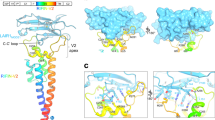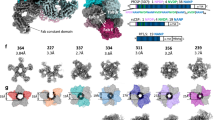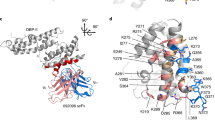Abstract
Some Plasmodium falciparum repetitive interspersed families of polypeptides (RIFINs)—variant surface antigens that are expressed on infected erythrocytes1—bind to the inhibitory receptor LAIR1, and insertion of DNA that encodes LAIR1 into immunoglobulin genes generates RIFIN-specific antibodies2,3. Here we address the general relevance of this finding by searching for antibodies that incorporate LILRB1, another inhibitory receptor that binds to β2 microglobulin and RIFINs through their apical domains4,5. By screening plasma from a cohort of donors from Mali, we identified individuals with LILRB1-containing antibodies. B cell clones isolated from three donors showed large DNA insertions in the switch region that encodes non-apical LILRB1 extracellular domain 3 and 4 (D3D4) or D3 alone in the variable–constant (VH–CH1) elbow. Through mass spectrometry and binding assays, we identified a large set of RIFINs that bind to LILRB1 D3. Crystal and cryo-electron microscopy structures of a RIFIN in complex with either LILRB1 D3D4 or a D3D4-containing antibody Fab revealed a mode of RIFIN–LILRB1 D3 interaction that is similar to that of RIFIN–LAIR1. The Fab showed an unconventional triangular architecture with the inserted LILRB1 domains opening up the VH–CH1 elbow without affecting VH–VL or CH1–CL pairing. Collectively, these findings show that RIFINs bind to LILRB1 through D3 and illustrate, with a naturally selected example, the general principle of creating novel antibodies by inserting receptor domains into the VH–CH1 elbow.
This is a preview of subscription content, access via your institution
Access options
Access Nature and 54 other Nature Portfolio journals
Get Nature+, our best-value online-access subscription
$29.99 / 30 days
cancel any time
Subscribe to this journal
Receive 51 print issues and online access
$199.00 per year
only $3.90 per issue
Buy this article
- Purchase on Springer Link
- Instant access to full article PDF
Prices may be subject to local taxes which are calculated during checkout




Similar content being viewed by others
Data availability
Sequence data for the monoclonal antibodies isolated in this study have been deposited in GeneBank (NCBI) with the accession codes MT897911 for MDA1, MT897912 for MDB1 and MT897913 for MDC1. The mass spectrometry differential expression data and MaxQuant search results can be found in the Source Data for Fig. 2. A list of tested RIFINs is also presented in the Source Data for Fig. 2. LILRB1 binding RIFIN prediction data from various parasite strains is presented in the Source Data for Extended Data Fig. 4. The crystal structure of LILRB1 D3D4 domain in complex with RIFIN PF3D7_1373400 V2 domain has been deposited in the PDB with accession number 7KFK. All other data are available from the corresponding author on request. Source data are provided with this paper.
References
Goel, S. et al. RIFINs are adhesins implicated in severe Plasmodium falciparum malaria. Nat. Med. 21, 314–317 (2015).
Tan, J. et al. A LAIR1 insertion generates broadly reactive antibodies against malaria variant antigens. Nature 529, 105–109 (2016).
Pieper, K. et al. Public antibodies to malaria antigens generated by two LAIR1 insertion modalities. Nature 548, 597–601 (2017).
Chapman, T. L., Heikema, A. P., West, A. P., Jr & Bjorkman, P. J. Crystal structure and ligand binding properties of the D1D2 region of the inhibitory receptor LIR-1 (ILT2). Immunity 13, 727–736 (2000).
Harrison, T. E. et al. Structural basis for RIFIN-mediated activation of LILRB1 in malaria. Nature 587, 309–312 (2020).
Wahlgren, M., Goel, S. & Akhouri, R. R. Variant surface antigens of Plasmodium falciparum and their roles in severe malaria. Nat. Rev. Microbiol. 15, 479–491 (2017).
Saito, F. et al. Immune evasion of Plasmodium falciparum by RIFIN via inhibitory receptors. Nature 552, 101–105 (2017).
Arama, C. et al. Ethnic differences in susceptibility to malaria: what have we learned from immuno-epidemiological studies in West Africa? Acta Trop. 146, 152–156 (2015).
Koning, M. T. et al. Templated insertions at VD and DJ junctions create unique B-cell receptors in the healthy B-cell repertoire. Eur. J. Immunol. 50, 2099–2101 (2020).
Higgins, M. K. & Carrington, M. Sequence variation and structural conservation allows development of novel function and immune evasion in parasite surface protein families. Protein Sci. 23, 354–365 (2014).
Tran, T. M. et al. An intensive longitudinal cohort study of Malian children and adults reveals no evidence of acquired immunity to Plasmodium falciparum infection. Clin. Infect. Dis. 57, 40–47 (2013).
Tiller, T. et al. Efficient generation of monoclonal antibodies from single human B cells by single cell RT-PCR and expression vector cloning. J. Immunol. Methods 329, 112–124 (2008).
Rieckmann, J. C. et al. Social network architecture of human immune cells unveiled by quantitative proteomics. Nat. Immunol. 18, 583–593 (2017).
Cox, J. & Mann, M. MaxQuant enables high peptide identification rates, individualized p.p.b.-range mass accuracies and proteome-wide protein quantification. Nat. Biotechnol. 26, 1367–1372 (2008).
Wheeler, D. L. et al. Database resources of the National Center for Biotechnology Information. Nucleic Acids Res. 35, D5–D12 (2007).
Sievers, F. & Higgins, D. G. Clustal Omega. Curr. Protoc. Bioinforma 2014, 3.13.1-16 (2014).
Kumar, S., Stecher, G., Li, M., Knyaz, C. & Tamura, K. MEGA X: Molecular evolutionary genetics analysis across computing platforms. Mol. Biol. Evol. 35, 1547–1549 (2018).
Suloway, C. et al. Automated molecular microscopy: the new Leginon system. J. Struct. Biol. 151, 41–60 (2005).
Punjani, A., Rubinstein, J. L., Fleet, D. J. & Brubaker, M. A. cryoSPARC: algorithms for rapid unsupervised cryo-EM structure determination. Nat. Methods 14, 290–296 (2017).
Pettersen, E. F. et al. UCSF Chimera–a visualization system for exploratory research and analysis. J. Comput. Chem. 25, 1605–1612 (2004).
Emsley, P. & Cowtan, K. Coot: model-building tools for molecular graphics. Acta Crystallogr. D 60, 2126–2132 (2004).
Adams, P. D. et al. PHENIX: a comprehensive Python-based system for macromolecular structure solution. Acta Crystallogr. D 66, 213–221 (2010).
Davis, I. W. et al. MolProbity: all-atom contacts and structure validation for proteins and nucleic acids. Nucleic Acids Res. 35, W375-W383 (2007).
Barad, B. A. et al. EMRinger: side chain-directed model and map validation for 3D cryo-electron microscopy. Nat. Methods 12, 943–946 (2015).
Acknowledgements
This work was partially supported by grants from the European Research Council (no. 670955 BROADimmune), the Fondation Louis-Jeantet, the Swiss Vaccine Research Institute, the Swiss National Science Foundation (grant no. 176165). The Mali study was funded by the Division of Intramural Research, National Institute of Allergy and Infectious Diseases, National Institutes of Health. We thank members of the Electron Microscopy Group at the New York Structural Biology Center (NYSBC) for assistance with data collection. This work was supported by the Intramural Research Program of the Vaccine Research Center, National Institution of Allergy and Infectious Diseases, NIH, by the GenScript Innovation grant GS-IG-2018-003 (K.X.), and by federal funds from the Frederick National Laboratory for Cancer Research, NIH, under Contract HHSN261200800001 (Y.T.). Use of sector 22 (Southeast Region Collaborative Access team) at the Advanced Photon Source was supported by the US Department of Energy, Basic Energy Sciences, Office of Science (contract W-31-109-Eng-38). Some of this work was performed at the Simons Electron Microscopy Center, and/or the National Resource for Automated Molecular Microscopy, and/or the National Center for Cryo-EM Access and Training located at the New York Structural Biology Center, supported by grants from the Simons Foundation (SF349247) and NIH National Institute of General Medical Sciences (GM103310) with additional support from NYSTAR and the New York State Assembly Majority.
Author information
Authors and Affiliations
Contributions
Y.C. isolated B cell clones, characterized genomic DNA, performed parasite cultures, produced recombinant antibodies, prepared proteomic samples, analysed the data and wrote the manuscript; K.X. performed structure analysis and wrote the manuscript; L.P. analysed the data and provided supervision; M.F. performed bioinformatics analysis; J.T. and C.S.-F. screened the Malian cohort and isolated B cell clones; W.J. helped with proteomics experiment; J.G., Y.T. and B.Z. helped with structure analysis; B.T. and P.D.C. provided cohort samples; R.G. performed proteomics analysis; F.S. and C.D. provided supervision and discussion; P.D.K. provided supervision and wrote the manuscript; A.L. provided overall supervision, analysed data and wrote the manuscript.
Corresponding author
Ethics declarations
Competing interests
Y.C., L.P., C.S.-F. and A.L. are currently employees of Vir Biotechnology Inc. and may hold shares in Vir Biotechnology Inc. The other authors declare no competing interests.
Additional information
Peer review information Nature thanks the anonymous reviewer(s) for their contribution to the peer review of this work. Peer reviewer reports are available.
Publisher’s note Springer Nature remains neutral with regard to jurisdictional claims in published maps and institutional affiliations.
Extended data figures and tables
Extended Data Fig. 1 Alignment of cDNA sequences of LILRB1-containing antibodies from donor A.
Shown are the sequences of antibodies isolated from MDA (donor A). Cryptic splicing sites (GT and AG) are marked in bold blue; alternative splicing sites are marked in bold red. MDA8 has a different splicing site in the intron between LILRB1 exon 7 encoding the D3 domain and exon 8 encoding the D4 domain, resulting in insertion of a piece of intronic sequence (originated from the intron between exons 7 and 8) before exon 8.
Extended Data Fig. 2 Alignment of cDNA and amino acid sequences of LILRB1-containing antibodies from three donors.
a, Protein sequences from MDA (donor A). b, cDNA sequence from MDB (donor B). c, Protein sequence from MDB. d, cDNA sequences from MDC (donor C). e, Protein sequences from MDC. Mutation in the D3 domain (p.Y291D) is highlighted in red.
Extended Data Fig. 3 Analysis of genomic sequences of the junction of switch regions containing LILRB1 domains from one representative clone of each donor.
a, MDA (donor A). b, MDB (donor B); the gene coordinates of the inserted exon 2 are indicated in red at the bottom. c, MDC (donor C). The annotations are colour coded as shown at the beginning of each panel. The reference sequences used are indicated at the bottom.
Extended Data Fig. 4 Identification of specific RIFINs recognized by MDB1 antibody.
a, Heatmap showing the enrichment of peptides in 3D7-MDB1+ infected erythrocytes from the LC–MS/MS analysis. The colour key indicates the value of log2LFQ (relative label-free quantification) intensity; the higher the value, the stronger the signal. b, Representation of RIFIN protein. RIFIN has two major conserved constant regions 1 and 2 (C1, C2), as well as two major variable regions (V1, V2). C, constant region; HP, hydrophobic patch; PEXEL, PEXEL motif; SP, signal peptide; TM, transmembrane region; V, variable region. The images are not drawn to scale. c, Alignment of representative full-length RIFIN proteins (PF3D7_0937700, PF3D7_1373400) and the definition of the V2 domain (coral pink). EF-hang motif (EF) is part of the C1 region defined by sequence alignment (highlighted in yellow). The legends are the same as in b. d, Workflow to identify additional RIFINs recognized by LILRB1-containing antibodies. Prediction of 141 LILRB1+ RIFINs from various strains (yellow) can be found in Source Data. e, FACS analysis of four additional LILRB1-binding RIFINs expressed on HEK293F transfectants stained with MDB1 antibody. LAIR-binding RIFIN PF3D7_1400600 is included as a control
Extended Data Fig. 5 3D7 RIFIN V2 phylogenetic tree.
Phylogenetic tree of 221 3D7 RIFIN V2 sequences. LILRB1+ RIFINs are highlighted in red. LAIR1+ RIFINs are highlighted in blue. Two previously reported LILRB1+ RIFINs are highlighted in orange.
Extended Data Fig. 6 3D7 RIFIN V2 homology analysis.
Homology analysis of LILRB1+ RIFINs and other RIFINs (RIFINs are colour coded as in Extended Data Fig. 5). Seven signatures shared among LILRB1+ RIFINs are marked with red asterisks. Amino acid conservation is shown in gradient blue (darker indicates higher conservation). PID, percentage identity.
Extended Data Fig. 7 Representative FACS plots of RIFINs binding to various constructs.
a,b, FACS analysis of representative RIFINs binding to natural or recombinant antibodies or control antibodies (representative of n = 3 independent experiments). c, FACS analysis of representative RIFINs binding to Fc fusion proteins containing LILRB1 domain/domains (representative of n = 2 independent experiments).
Extended Data Fig. 8 Cryo-EM data processing and validation.
a, A representative cryo-EM micrograph showing MDB1–RIFIN complex embedded in vitreous ice. b, Overall resolution estimation (FSC, 0.143). c, Representative 2D average classes. d, Local resolution estimation of the cryo-EM map. e, Cryo-EM density and refined models for a representative region.
Extended Data Fig. 9 Structural analysis of MDB1 and various modes of RIFIN–receptor interaction.
a, Triangular architecture of LILRB1-containing MDB1 antibody Fab and structural comparison. Inside the ellipse is shown a schematic view of MDB1 with RIFIN attached to one arm of the Fab. The insets show structural superimposition of MDB1 domains on a non-inserted antibody and on apo LILRB1 (upper left: VH–VL region aligned with PDB 6P3B; upper right: CH–CL region aligned with PDB 6P3B; bottom right: LILRB1 insertion aligned with PDB 4LLA). b, Comparison of LILRB1/LAIR1 (grey) recognition by RIFIN PF3D7_1373400 (yellow) and RIFIN PF3D7_1040300 (PDB 7JZI, cyan). c, Comparison of LILRB1 (D1D2 in grey, D3D4 in red) recognition by RIFIN PF3D7_1254800 (PDB 6ZDX, green) and RIFIN PF3D7_1373400 (yellow).
Extended Data Fig. 10 Scheme of receptor-based antibodies hijacking binding of RIFIN to host inhibitory receptors.
a, Immune cells such as B cells, T cells and natural killer (NK) cells express the inhibitory receptors LILRB1 or LAIR1 on the cell surface. Infected erythrocytes express surface variant antigen RIFINs that can target host inhibitory receptors such as LILRB1 or LAIR1 for immune invasion. Cross-linking of HLA-I on cells with the LILRB1 D1D2 domain can deliver a negative regulatory signal to the LILRB1-expressing cells. LAIR1 binds to C1q or collagen-like domains. LAIR1, blue; C1q, yellow; LILRB1, red; HLA-I, grey; LILRB1-specific RIFIN, light pink; LAIR1-specific RIFIN, light blue. b, The host immune system developed natural receptor-based antibodies to combat the evasion mechanism used by infected erythrocytes. The LILRB1-containing antibody does not cross-react with RIFINs that are specific for LAIR1. Antibody heavy chain VH, dark green; constant region CH, grey; light chain VL, light green; light chain constant CL, light grey.
Supplementary information
Supplementary Information
This file contains Supplementary Tables 2-4 and Supplementary Figures 1-2.
Rights and permissions
About this article
Cite this article
Chen, Y., Xu, K., Piccoli, L. et al. Structural basis of malaria RIFIN binding by LILRB1-containing antibodies. Nature 592, 639–643 (2021). https://doi.org/10.1038/s41586-021-03378-6
Received:
Accepted:
Published:
Issue Date:
DOI: https://doi.org/10.1038/s41586-021-03378-6
This article is cited by
-
Structural basis of LAIR1 targeting by polymorphic Plasmodium RIFINs
Nature Communications (2021)
-
Immunoglobulin germline gene variation and its impact on human disease
Genes & Immunity (2021)
Comments
By submitting a comment you agree to abide by our Terms and Community Guidelines. If you find something abusive or that does not comply with our terms or guidelines please flag it as inappropriate.



